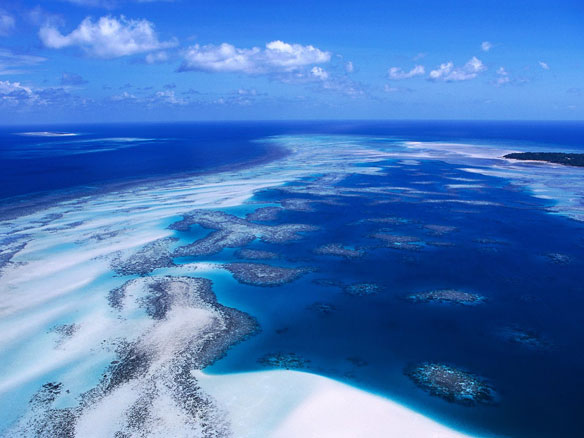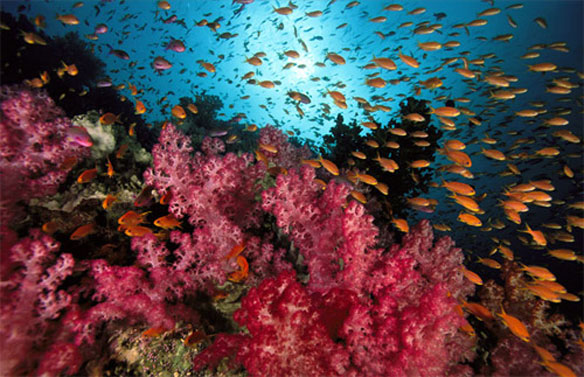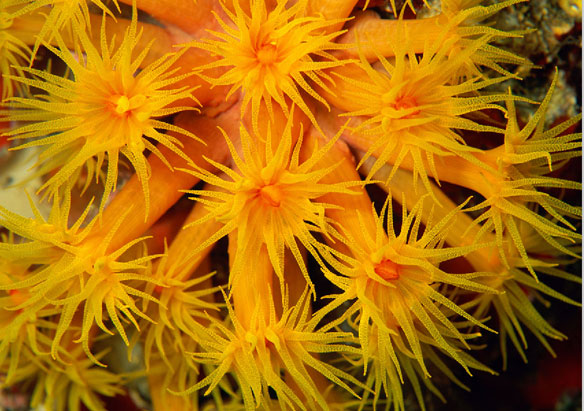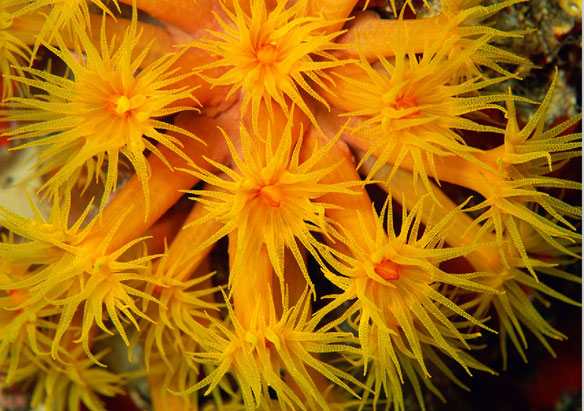
Coral Reef, Strait Islands, Australia
By Robert Lalasz, Nature Conservancy, An Interview with Mark Spalding, Conservancy marine scientist
The new Reefs at Risk Revisited report is out, 13 years after the original Reefs at Risk, which was the first global assessment of the threats to Earth’s coral reefs and painted an alarming picture of their future. Today’s edition is even less rosy: It reports that 75% of the planet’s reefs are threatened, not just by unsustainable fishing practices and development but also by the effects of climate change.
Amazingly, Mark Spalding, Conservancy marine scientist and a co-author for both editions, is still optimistic we can save coral reefs. I asked him why and to tell us what’s in the new report.
Amazingly, Mark Spalding, Conservancy marine scientist and a co-author for both editions, is still optimistic we can save coral reefs. I asked him why and to tell us what’s in the new report.
You were part of the first Reefs at Risk report, published more than a decade ago. What’s changed? Are things that much worse for coral reefs now, and why?
Mark Spalding : The 1998 report was a wakeup call. It was the first reliable assessment of the scale of the problems facing reefs, and we found those problems, such as unsustainable fishing, coastal development, pollution and sediments sweeping off the land, were truly global and piling up to create huge challenges.
Our findings spurred vast efforts that spent hundreds of millions of dollars to deal with these problems. But while I’d love to tell you we’ve turned things around over the last decade, we haven’t. In fact, there’s been a 30% increase in the area of threatened reefs. Oceans have warmed because of climate change, and that’s caused devastating coral bleaching in many areas.
It would be wrong to talk about failure, though. Reefs would be in much worse condition in many places if we hadn’t done what we’ve done. There are now literally thousands of examples of good reef management worldwide, and of how to turn coral reefs around. We need to pick up these examples and see them as a tool-kit, something we can turn into standard management practice across the globe. For peoples’ sake.
The report says 75% of the world’s reefs are threatened. What does “threatened” mean, exactly, are they on the verge of disappearing, or no longer functioning?
Mark Spalding : A bit of both. Some of our “threatened” reefs are to all intents and purposes lost, while others on the map still appear to be in good health. But most of that 75% are degraded to some degree: fewer fish, fewer corals, banks of seaweed smothering the sea floor.
Reefs at Risk isn’t a measure of conditions in the water, it’s a scientific best estimate of how things could affect reefs. In some cases, these threats are like shadows, waiting in the wings; elsewhere, they have begun to tip the balance. And as these reefs decline, coastal people start to lose out too, from declines in fishing, failing tourism revenues, or weakening protection against storms by the ramparts of living reef.
If you had to pick one threat that’s gotten dramatically worse over the last 10 years, which would it be?
Mark Spalding: Coral bleaching, without a doubt. Bleaching is a stress response: when the water gets just a bit too warm, the corals pale to a bleached white and lose the important algae that normally live inside their bodies. Bleaching can kill corals over vast areas in extreme cases.
We knew bleaching was a threat as we worked on the last study, but no reef scientist had predicted the scale of the problem. It has just come on so fast, so strong, it’s hammered many reefs, and left other corals more susceptible to disease or other impacts.
Recent bleaching has increased the percentage of threatened reefs from 61% to 75%. Future projections of bleaching’s effects are even scarier. Until we get global change and carbon emissions under control, the threats from coral bleaching — and ocean acidification, as the ocean absorbs more CO2, will continue and accelerate.
Let’s do a thought experiment: Coral reefs have vanished overnight. What are the results? What do we lose? Who suffers? How would it affect the developed world?
Mark Spalding : First off, the 275 million people who live near coral reefs would be devastated. There are 150,000 km of worldwide coastline sheltered behind reefs, which provide storm and wave protection. And these aren’t just people on remote islands, while coral reefs provide critical food and shelter for villages and farms, they’re also critical to the functioning of countless towns, businesses and even cities from Miami to Manila. There are entire nations built from coral reefs, whose land surface is nothing more than the accumulated remains of corals shaped into islands by storms and currents. So all that would go away.

Healthy coral reefs provide a living for about 275 million people, with many more dependent on them. Photo Source: National Geographic
But the ramifications are so much bigger than the local. Tourism, for one: Reef tourism is a massive industry, bringing international travellers to 100 coral reef nations around the world, and providing one-third of all export earnings to around 20 of these countries. And there are the vicarious benefits from the reefs’ supplies, from exotic food to aquarium fishes.
Equally important are the potent chemicals of the reefs and their medicinal uses and potential. Like rainforests, coral reefs host a bewildering diversity of plants and animals. In systems this diverse, the struggle for survival leads many species to develop complex adaptations, from skeletal structures to poisons and venoms. There might be 1 million different animal species on the world’s reefs, and we have only just begun to look at them. But they’ve already yielded active compounds with considerable promise for the treatment of certain cancers, HIV and malaria.
It’s frightening to think of coral reefs disappearing. The flip side: Give reefs a chance and the payback to people could be vast, and could continue in perpetuity.
The report calls for increased protection of coral reefs, but 27% of the world’s reefs are already inside marine protected areas (MPAs), and you write those aren’t completely effective. How do we increase the effectiveness of existing MPAs for reefs as well as their coverage?
Mark Spalding : It’s true. We found that only 6% of reefs were in fully effective MPAs, sites that allow fish and other organisms to thrive without any significant human impact. And quite a lot of those effective sites are very remote from the threats.
We know that MPAs are good for reefs. We also know that, as fish stocks recover in MPAs, they allow increased catches for fishers and better diving for tourists. So we need more MPAs close to people, precisely in the places that the threats are highest.
But these aren’t easy fixes, there is competition for use in these places, and some will resist any efforts to restrict or control fishing or other impacts. The Conservancy has been working around the world with fishers as well as with governments to design protected areas, and, indeed, comprehensive ocean zoning, to lead to benefits for all. Success breeds success in these matters, and the best emissaries for MPAs are their beneficiaries. Marine conservationists should be using fishers from successful locations to spread the word to others.
Given the dramatic decline in the condition of reefs since the last Reefs at Risk appeared, why should we be optimistic that we can avoid widespread disaster for coral reefs?
Mark Spalding : It would be foolish to simply wear a happy smile and pretend “all shall be well”, this report clearly points to a very sobering reality. But the report is also filled with success stories, everything from inspiring community leaders and well-managed local areas through to large-scale marine parks and international agreements such as the Micronesia Challenge. We can turn things around. We can manage reefs for survival, or even for rapid recovery. And in so doing, we can strengthen our coastlines and feed more hungry mouths.
Climate change hangs over such optimism, though, our projections suggest that reefs may be defenseless against its worst ravages. But we can certainly buy ourselves time. Some reefs have shown remarkable resilience and a great ability to bounce back from bleaching impacts to date, so if we can persuade the global community to act on climate change soon there’s certainly hope.
There are more than 60 recommendations in this new report for policymakers, scientists, industry. What can ordinary people do to help coral reefs? Anything?

Photo Source: National Geographic
Mark Spalding : Individuals have a critical part to play. If you live near a reef, get involved. Help local communities and organizations with reef conservation and lobby leaders for better management. Fish with due caution and be careful not to drive overfishing when you buy fish from others.
And even if you live far from reefs, you can help, too. Do you holiday in reef areas, or know people who do? Think about where you stay and don’t be afraid to ask questions, choose hotels and restaurants that do not pollute and that make a positive contribution to the environment. Support NGOs such as The Nature Conservancy, which are making a real difference to coral reef conservation on the ground. Reduce your own personal carbon footprint, too, this step is urgent and, while it won’t be enough, it sends a powerful message. Finally, tell others what you are doing and encourage them to do the same.
Coral reefs heading for fishing and climate crisis, BBC
The Last Of The Sea Nomads, Destroying The Reefs That Sustain Them, in Coastal Care









